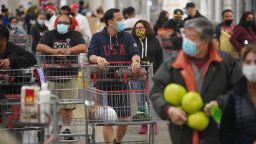President Joe Biden is taking the political punches for high inflation. But price stability is the responsibility of the Federal Reserve, not the White House. And prices are anything but stable right now.
Consumer prices spiked in November at the fastest pace since 1982. Producer prices soared by nearly 10%, suggesting inflationary pressures are not subsiding anytime soon.
The good news is that the Federal Reserve knows how to fight inflation: By tapping the brakes on the economy. The bad news is the harder it hits the brakes, the greater the risk of an accident that ends the economic recovery, freaks out financial markets – or both.
“The Fed knows what to do, but they don’t necessarily know how to do it without squashing the economy,” Lisa Shalett, chief investment officer of Morgan Stanley Wealth Management, told CNN.
Federal Reserve Chairman Jerome Powell, fresh off his renomination by Biden, will attempt to assure Wall Street, Washington and the public at large on Wednesday there’s no reason to panic about sticker shock.
Powell must promise to get inflation under control – but do so without removing support so quickly that the recovery stalls out. It’s a difficult needle to thread.
“Pressures on the Fed now are intensifying and enormous,” David Kotok, chairman and chief investment officer at Cumberland Advisors, told CNN in an email.
‘He’s got to fall on his sword’
Powell’s task is complicated by how wrong the Fed and the consensus among economists has been. Very few people expected inflation at the end of 2021 to be this hot for this long.
Mohamed El-Erian, chief economic adviser at Allianz, told CBS the Fed’s characterization of inflation as transitory “is probably the worst inflation call in the history of the Federal Reserve.”
The Fed chief has already, wisely, suggested that it’s time to retire his description of inflation as transitory.
“Powell needs to eat his words. He’s got to fall on his sword. Inflation is no longer transitory,” said Shalett.
New numbers out on Tuesday showed that producer prices, those charged by suppliers to businesses, spiked by 9.6% from a year ago. That’s the highest on record since the government started tracking this metric in 2010.
“These are provocative numbers, by any stretch of the imagination,” said Shalett, who added she’s more concerned about inflation today than at any point during her three-decade career on Wall Street.
Negative feedback loop
Biden has acknowledged that high inflation is squeezing families. But he’s also argued that inflation is peaking now.
That may very well be the case. Many economists do think inflation will cool off in 2022 and that the price spike may be at or near a peak. But it’s very hard to accurately forecast anything in the Covid economy. And even if the worst of inflation is over soon, that doesn’t mean prices will automatically revert back to healthy levels.
Inflation was very tame in the aftermath of the Great Recession. For years, the Fed fretted that inflation was too low. Falling prices are scary for central bankers because it’s very difficult to escape a deflationary spiral.
But Covid has changed that. Supply chain bottlenecks, worker shortages and surging demand as the world recovers from the pandemic have set off a bout of inflation. Consumer prices are up by 5% or more during each of the past six months. That’s nowhere near the Fed’s goal for roughly 2% inflation.
“The more persistent it is, the more likely it becomes embedded in the economy. That’s what is troubling in the recent inflation prints,” Ethan Harris, head of global economics at Bank of America, told CNN.
If everyone starts to anticipate higher prices, they will change their behavior. Workers will demand higher and higher wages. Consumers will pull forward their purchases. And all of that will add further pressure on inflation. It becomes a negative feedback loop.
“It starts to enter the psychology of the economy,” said Harris.
How the Fed can fight inflation
Unlike deflation, the Fed knows it can address inflation by raising the cost of money.
In this case, that means unwinding the Fed’s bond-buying stimulus program, known as quantitative easing, or QE. Despite the booming economy and red-hot inflation, up until very recently the Fed was buying a staggering $120 billion of mortgage and Treasury bonds a month.
But that program is only piling pressure on inflation and Powell has signaled a willingness to speed up the demise of QE. Look for the Fed to endorse a faster “taper” of QE on Wednesday.
And Fed officials will likely signal that interest rates will have to rise off rock-bottom levels to combat inflation. Wall Street is pricing in at least two interest rate hikes next year, a big reversal from earlier this year when many assumed the Fed could stay at zero until 2023.
Current Fed policy (zero rates and massive QE) is “insane” given inflationary pressures and the strength of the underlying economy, Shalett said.
The Volcker playbook
Paul Volcker, the legendary former chairman of the Fed, tamed the runaway inflation of the 1970s and early 1980s by dramatically raising interest rates.
While Volcker’s success earned him a place in the history books, what often gets overlooked today is the economic pain those rate hikes inflicted on the economy. Under Volcker, interest rates skyrocketed to an unprecedented 20%, crushing the economy by raising the cost of everything from mortgages, small business loans and car loans.
“Everyone talks about Paul Volcker as a hero. But the United States economy was in a double-dip recession between 1981 and 1984,” said Shalett. “Everyone has said this is not the 1970s. But I don’t know that we know that for sure.”
Curiously, the bond markets are not freaking out about the high inflation readings. The 10-year Treasury rate stands at about 1.45% today, down from 1.7% in mid-October.
Kotok, the Cumberland Advisors chairman, said the bond market is more concerned about the Fed overreacting to today’s hot inflation readings than it is about the hot inflation readings themselves.
And Kotok shares that concern.
“I fear a policy error that goes too far, too fast and throws the US economy into a slowdown or recession,” Kotok said. “History suggests that is a very real possibility.”



























